We continue the story of the History of Cricket in the West Indies. In our previous post, we discussed the history of West Indian cricket from the start until 1950. Now, we look at the 1950s to 1980s.
History of Cricket in West Indies – 1950 to 1960
The 1950s marked a significant turning point for West Indies cricket, as the region began to establish itself as a competitive force on the international stage. This era saw the rise of legendary players, landmark victories, and a growing sense of unity among the Caribbean islands. As West Indies cricket moved towards greater professionalism and consistency, the foundation was laid for future dominance.
The Continued Rise of the Three Ws: Worrell, Weekes, and Walcott
We mentioned the Three W’s in the previous post – Sir Frank Worrell, Everton Weekes, and Clyde Walcott. These three great Barbadian batsmen made their debuts in 1948, but it was the 1950s where they really made their names. They revolutionized West Indies cricket with their extraordinary skills and charismatic presence. Their contributions were pivotal in transforming the West Indies into a formidable team capable of competing against the best in the world.
Frank Worrell, known for his elegant batting style and leadership qualities, was more than just a cricketer; he was a symbol of hope and inspiration for the Caribbean. Worrell’s calm demeanour and strategic thinking on the field made him an invaluable asset to the team.
Everton Weekes, with his aggressive batting and exceptional ability to score runs quickly, was a nightmare for bowlers around the world. Weekes’ consistency and hunger for runs earned him a reputation as one of the finest batsmen of his era.

Clyde Walcott See page for author, Public domain, via Wikimedia Commons
Clyde Walcott, a powerful batsman and versatile wicketkeeper, brought strength and stability to the middle order. His ability to play both defensively and aggressively made him a key player in many of the West Indies’ successes during this period.
Together, the Three Ws formed the backbone of the West Indies batting lineup. Their partnership and individual brilliance not only led to numerous victories but also inspired a generation of young cricketers across the Caribbean. They embodied the spirit of unity and excellence, setting a high standard for future West Indies teams to follow.
The 1950 Test Series Victory in England
One of the most significant achievements for the West Indies during the 1950s was the historic Test series victory in England in 1950. This series win was a monumental event, marking the first time the West Indies had defeated England in a Test series on English soil. The 3-1 series win was not just a triumph on the cricket field but also a powerful statement of Caribbean pride and potential.
The series was characterized by the outstanding performances of spinners Sonny Ramadhin and Alf Valentine. Both bowlers, relatively unknown at the start of the tour, quickly became the stars of the series. Ramadhin, with his mysterious off-spin, and Valentine, with his left-arm orthodox spin, bamboozled the English batsmen. Ramadhin took 26 wickets and Valentine 33, showcasing the effectiveness of spin bowling in the West Indies’ arsenal.
The series win in England was celebrated throughout the Caribbean, igniting a sense of national pride and unity. It demonstrated that the West Indies could compete with and defeat one of the strongest teams in the world, challenging the colonial narrative that often portrayed Caribbean nations as inferior. This victory laid the groundwork for future success and solidified the West Indies’ reputation as a rising cricketing power.
The Dominance of Spin Bowling in the 1950s
While the West Indies would later become known for their fast bowlers, the 1950s were marked by the brilliance of their spin attack. Spin bowlers like Sonny Ramadhin and Alf Valentine played pivotal roles in the team’s success during this decade, particularly in the historic series victory against England in 1950.
Ramadhin and Valentine were a formidable duo, known for their ability to extract turn and bounce from even the most placid of pitches. Their contrasting styles — Ramadhin’s off-spin and Valentine’s left-arm orthodox — provided a balance and variety that made them a potent combination. Ramadhin’s subtle variations and control over flight and length made him a constant threat to batsmen, while Valentine’s ability to bowl long, economical spells without losing his accuracy made him an invaluable asset.
The dominance of spin bowling in the 1950s was a defining feature of West Indies cricket during this era. It provided the team with a unique advantage and allowed them to compete effectively against more experienced and well-established teams. The success of Ramadhin and Valentine also paved the way for future generations of West Indian spinners and highlighted the importance of developing a well-rounded bowling attack.
Sonny Ramadhin played 44 tests between 1950 and 1960, taking 158 wickets at an average of 28.98, ten times taking 5 wickets in an innings.
Alf Valentine played 36 tests between 1950 and 1962, taking 139 wickets at an average of 30.32. Eight times he took 5 wickets in an innings.
Through the contributions of these players and the strategic leadership of their captains, the 1950s became a foundational decade for West Indies cricket. The achievements of this era set the stage for the West Indies’ emergence as a cricketing powerhouse in the following decades, laying the groundwork for a legacy that would inspire future generations.
The Stats: West Indian Stats between 1950 and 1960
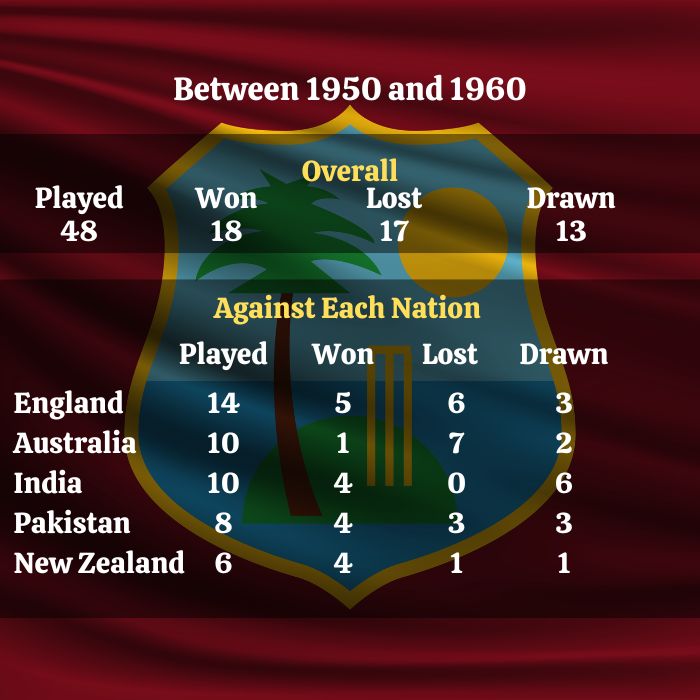
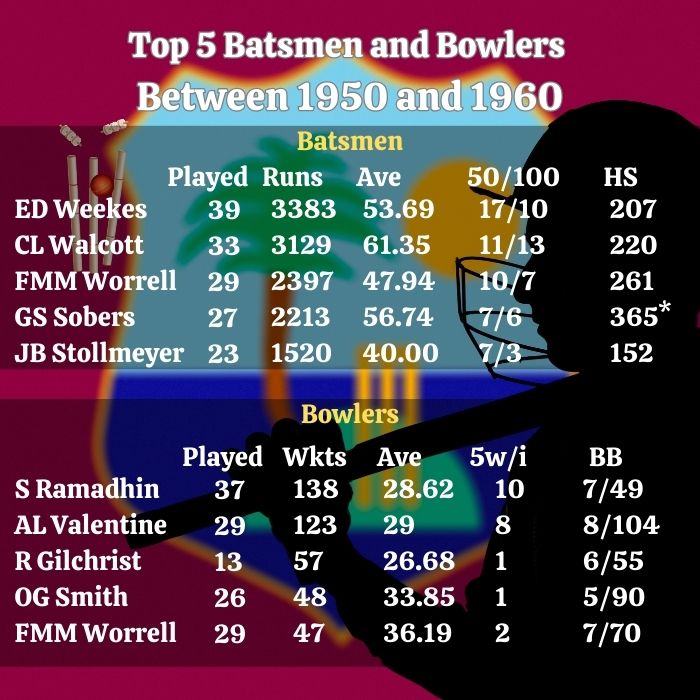
1960s: Transition and Transformation
The 1960s were a decade of transition and transformation for West Indies cricket. This era saw the team evolve in terms of strategy, leadership, and composition. The West Indies emerged as a stronger side, largely due to the rise of new talents and the development of a potent fast-bowling attack. However, the decade also posed significant challenges as the team struggled with consistency and cohesion amidst the backdrop of political and social changes in the Caribbean.
The Worrell Legacy: The First Black Captain of the West Indies
One of the most defining moments in West Indies cricket during the 1960s was the appointment of Sir Frank Worrell as the team’s captain in 1960. Worrell became the first Black captain of the West Indies for an entire series, a landmark decision that had profound implications not just for cricket but for Caribbean society as a whole. His appointment marked a departure from the colonial past and was a significant step towards greater racial equality and representation in the region.
Worrell’s leadership style was characterized by inclusivity, unity, and inspiration. He emphasized teamwork and the importance of playing as a unified Caribbean team, regardless of the players’ island origins. Under his captaincy, the West Indies played with a renewed sense of purpose and discipline. Worrell’s ability to bring together players from diverse backgrounds and instil a strong sense of identity and pride was a critical factor in the team’s success during this period.
One of Worrell’s most notable achievements as captain was leading the West Indies on the historic 1960-61 tour of Australia, which included the first-ever tied Test match. His sportsmanship and positive approach to the game won him respect and admiration worldwide, making him a beloved figure both in the Caribbean and internationally. Worrell’s legacy as a leader extended beyond the cricket field, as he became a symbol of Caribbean unity and progress.
The Emergence of Fast Bowling in the 1960s
While the 1950s were marked by the dominance of spin bowling, the 1960s witnessed a significant shift in the West Indies’ bowling strategy with the emergence of fast bowlers like Wes Hall and Charlie Griffith. These bowlers brought a new dimension to the West Indies attack, characterized by pace, aggression, and intimidation.
Wes Hall, known for his express pace and hostile bowling, was a key figure in the transformation of the West Indies bowling lineup. Standing at 6 feet 5 inches, Hall’s physical presence and fiery temperament made him a daunting prospect for batsmen. His ability to bowl long spells with sustained speed and accuracy added a cutting edge to the West Indies’ attack.
Hall’s most famous spell came during the 1960-61 tour of Australia, where he bowled the last over in the tied Test at Brisbane, nearly securing a win for the West Indies.
Charlie Griffith, another formidable fast bowler, complemented Hall with his raw pace and ability to swing the ball. Griffith’s career was marked by controversy due to allegations of a suspect bowling action, but his effectiveness as a bowler was undeniable. Together, Hall and Griffith formed a potent new-ball partnership that laid the foundation for the West Indies’ fast-bowling legacy.
The shift towards a pace-oriented attack was a strategic decision that would define West Indies cricket for decades to come. The aggressive, fast-bowling approach became synonymous with West Indies cricket and was instrumental in the team’s rise to dominance in the 1970s and 1980s.
Gary Sobers: The Rise and Rise Of A Gret All Rounder

Gary Sobers, 1956 Unidentified photographer, Public domain, via Wikimedia Commons
Gary Sobers, widely regarded as one of the greatest all-rounders in cricket history, was a transformative figure for West Indian cricket. While he had already established himself in the 1950s as a great cricket, he continued to build on his reputation, averaging over 60 with the bat during the decade. This is on top of taking 162 wickets and 32.29 during his 49 tests during the decade.
Born in Barbados in 1936, Sobers made his debut for the West Indies at just 17 years old and soon showcased his exceptional talent. His ability to excel in all aspects of the game—batting, bowling, and fielding—set him apart from his contemporaries.
Sobers’ batting prowess was evident when he set a world record for the highest individual score in Test cricket with 365 not out against Pakistan in 1958, a record that stood for 36 years.
As a bowler, he was versatile, capable of delivering fast-medium pace, orthodox spin, and chinaman, making him a formidable opponent.
His remarkable athleticism in the field added another layer to his comprehensive skill set. Beyond statistics, Sobers was a charismatic leader and played a crucial role in establishing the West Indies as a dominant force in international cricket during the 1960s and 1970s.
His contributions to the game extended off the field, where he became a revered figure and an ambassador for cricket, embodying sportsmanship and inspiring future generations of cricketers worldwide.
Sir Garfield Sobers played 93 tests from 1954 to 1974, scoring 8,032 runs at an average of 57.78 with 26 centuries and a highest score of 365 not out. He also took 235 wickets at an average of 34.03, taking 5 wickets in an innings 6 times, with best figures of 6/73.
He even played one single one day match, and while he took 1/31, he was out without scoring in his single innings.
West Indies’ 1960-61 Series in Australia
The 1960-61 Test series between the West Indies and Australia is often remembered as one of the most exciting and competitive series in cricket history. This tour was significant for several reasons, not least because it featured the first-ever tied Test match, played at the Brisbane Cricket Ground (The Gabba). The series captured the imagination of cricket fans worldwide and showcased the talents and fighting spirit of the West Indies team.
Under the captaincy of Frank Worrell, the West Indies approached the series with a positive and attacking mindset. The first Test in Brisbane, ended in a tie, following one of the most dramatic final overs in a test match, in which 3 wickets fell.
The series continued to be closely contested, with both teams displaying remarkable skill and resilience. The West Indies lost the five-match series 2-1, but their spirited performance won them many admirers. The series was also a turning point in the relationship between the two teams, fostering a sense of mutual respect and camaraderie that would endure for years.
The 1960-61 series against Australia was a pivotal moment for West Indies cricket, demonstrating that they could compete with the best teams in the world on equal terms. The series was also a testament to the positive impact of Frank Worrell’s captaincy and the emergence of a new era of West Indies cricket.
Challenges of Consistency: Struggles in International Series
Despite the many achievements of the 1960s, the West Indies also faced significant challenges in maintaining consistency during this period.
After an initial loss to England 1-0 and the 2-1 loss in Australia in 1960/61, West Indies won the next 5 series in a row against India (Home: 5-0), England (Away: 3-1), Australia (Home: 2-1), England (Away: 3-1), India (Away: 2-0), before losing their last 4 series of the decade.
Several factors contributed to the West Indies’ struggles during the decade. The departure of key players, such as the Three Ws (Sir Frank Worrell, Everton Weekes, and Clyde Walcott), left a void in the batting lineup that was not immediately filled.
While new talents emerged, the team lacked the depth and experience needed to consistently compete at the highest level. Additionally, the team’s reliance on a few star players, particularly in the bowling department, made them vulnerable when those players were out of form or injured.
The West Indies also faced challenges off the field, including issues related to selection, management, and the politics of cricket administration. Regional rivalries and differences sometimes affected team cohesion and decision-making, hindering the development of a unified approach.
Despite these challenges, the 1960s were a crucial period of growth and learning for the West Indies. The experiences of this decade, both the successes and the struggles, helped shape the team’s character and laid the foundation for the golden era of West Indies cricket in the mid-to-late-1970s and 1980s. The lessons learned during the 1960s would prove invaluable as the team continued to evolve and build towards future success.
The Stats: West Indian Stats between 1960 and 1970
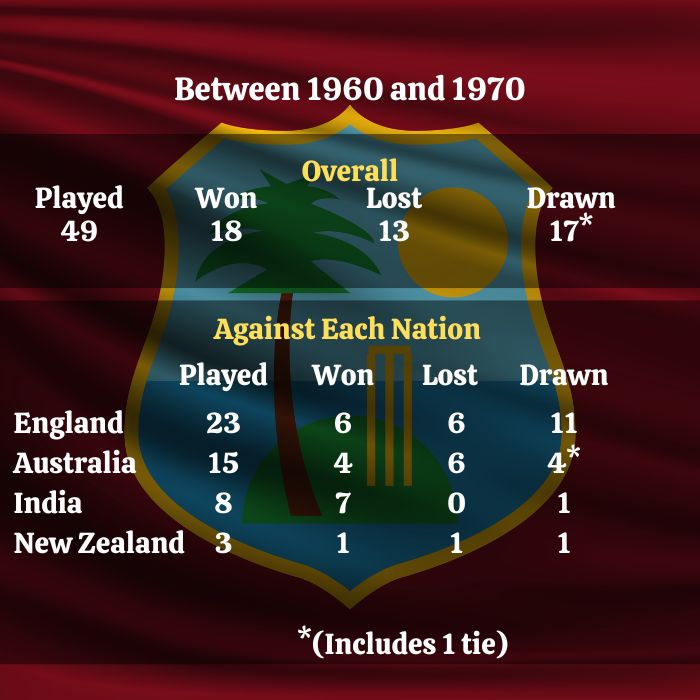
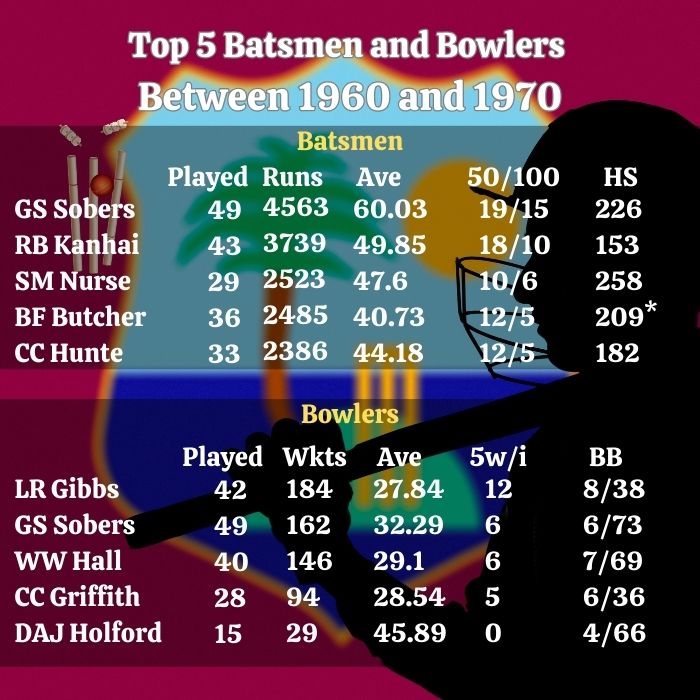
1970s: Rise to Superpower Status
The 1970s marked a transformative decade for West Indies cricket, as the team evolved from a competitive side into a dominant force in international cricket. This period saw the emergence of a new generation of cricketers, innovative leadership, and a shift in strategy that prioritized fast bowling and aggressive play. The successes of this decade laid the foundation for the West Indies’ dominance in the following years and established their reputation as a cricketing superpower.
The 1975/76 Series Against India: A Turning Point
The 1975/76 Test series against India was a pivotal moment in West Indies cricket, marking the beginning of their rise to global dominance. After losing to Australia in a gruelling Test series 5-1 in 1975-76, the West Indies team, under the leadership of Clive Lloyd, embarked on a tour of India determined to prove their mettle. This series would not only test the team’s resilience but also redefine their approach to the game.
The West Indies emerged victorious in the four-match series, winning 2-1. The series was notable for the introduction of the aggressive fast-bowling strategy that would become the hallmark of West Indies cricket. The fast bowlers, including Michael Holding and Andy Roberts, unleashed a barrage of short-pitched deliveries, intimidating the Indian batsmen and exposing their vulnerability to pace.
The success in India was a turning point for the West Indies, instilling a sense of confidence and belief in their ability to dominate opponents through sheer pace and aggression. This series laid the groundwork for the team’s future strategy, which would revolve around a formidable fast-bowling attack and a fearless, attacking style of play.
For the next twenty years, the West Indies would dominate test cricket. Of the 35 test series they would play during that time, they would lose only 2 (1/0 v India 1978/79, and 1-0 against New Zealand 1979/1980) and draw 8.
The Packer Revolution: Impact on West Indies Cricket
The late 1970s also saw the impact of the Packer Revolution, which had a profound effect on cricket worldwide, including in the West Indies. In 1977, Australian media mogul Kerry Packer established World Series Cricket (WSC), a breakaway competition that attracted many of the world’s best players, including several from the West Indies.
Clive Lloyd, Viv Richards, Michael Holding, Andy Roberts, and other key West Indies players joined the WSC, drawn by the promise of better pay and improved playing conditions. While the move was initially controversial, as it led to a split with traditional cricket boards, it ultimately benefited the players and the sport.
The WSC introduced innovations such as coloured clothing, day-night matches, and improved broadcast techniques, which significantly increased the entertainment value of cricket.
For the West Indies, participation in the WSC provided financial stability and allowed the players to develop their skills against top-quality opposition. The experience gained from playing in WSC helped to hone the West Indies’ fast-bowling strategy and contributed to their dominance in international cricket during the late 1970s and 1980s.
Clive Lloyd’s Leadership: The Birth of a Dominant Era

Clive Lloyd Bollywood Hungama, CC BY 3.0, via Wikimedia Commons
Clive Lloyd’s captaincy was instrumental in transforming the West Indies into a dominant force in world cricket during the 1970s. Appointed captain in 1974, Lloyd brought a new vision and approach to the team, emphasizing unity, discipline, and a winning mentality. Under his leadership, the West Indies adopted a more aggressive style of play, characterized by a powerful batting lineup and a fearsome fast-bowling attack.
Lloyd’s leadership style was marked by his ability to inspire and motivate his players. He fostered a strong team spirit and a sense of collective identity, encouraging his players to take pride in representing the Caribbean as a unified entity. Lloyd also emphasized the importance of fitness and professionalism, ensuring that his team was always well-prepared and mentally tough.
One of Lloyd’s most significant contributions was his decision to build the team around a core group of fast bowlers. He recognized the potential of his pace attack, which included legends like Michael Holding, Andy Roberts, Joel Garner, and Colin Croft, and used them to devastating effect.
This strategy paid dividends, as the West Indies’ fast bowlers dominated opposition batting lineups and played a crucial role in the team’s success during the decade.
The Stats: West Indian Stats between 1970 and 1980
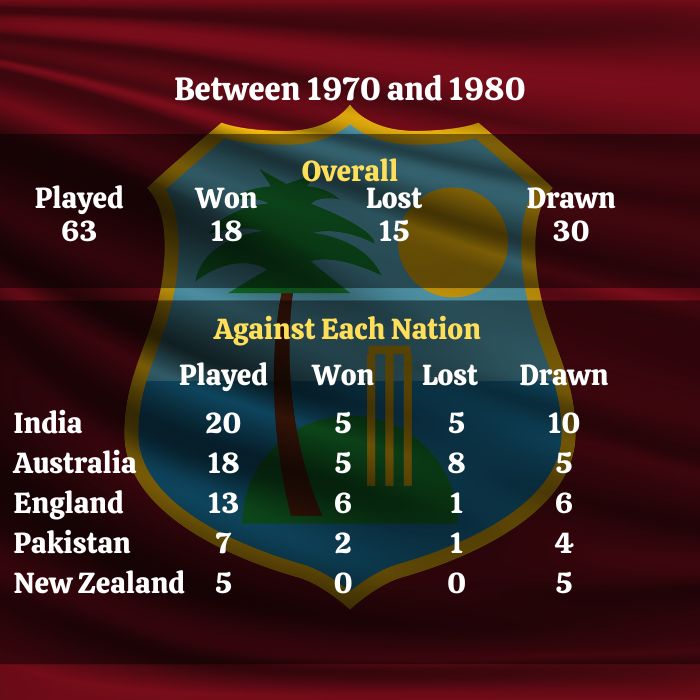
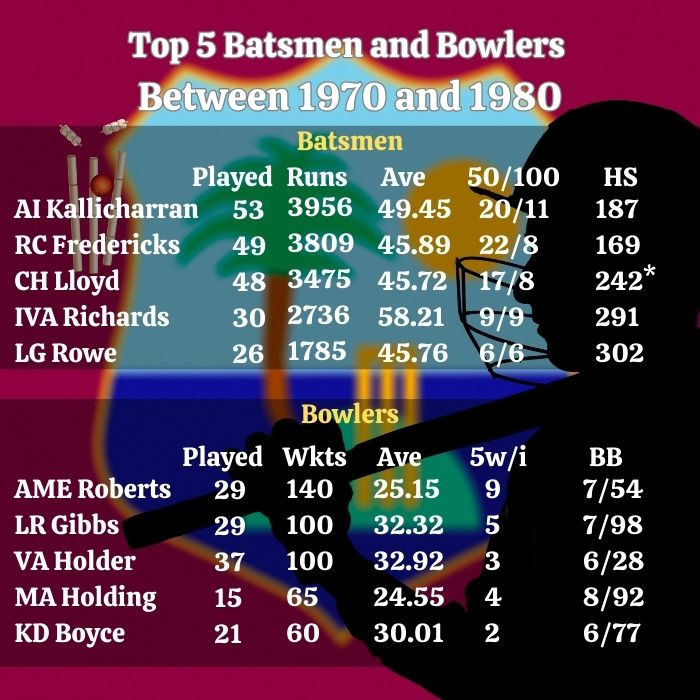
One Day Cricket: Triumphs in the 1975 and 1979 World Cups
The 1970s also saw the West Indies establish themselves as a powerhouse in One Day International (ODI) cricket, with their triumphs in the inaugural 1975 Cricket World Cup and the 1979 Cricket World Cup. These victories not only showcased the team’s versatility and adaptability across formats but also solidified their reputation as one of the best cricketing sides in the world.
In the 1975 World Cup, held in England, the West Indies were led by Clive Lloyd and featured a balanced team with a mix of explosive batting, disciplined bowling, and sharp fielding. The West Indies cruised through the group stage and reached the final, where they faced Australia. Lloyd played a captain’s innings in the final, scoring a magnificent 102 off 85 balls to lead his team to victory. The West Indies won the final by 17 runs, claiming the first-ever World Cup and establishing themselves as the preeminent force in one-day cricket.
The West Indies continued their dominance in the 1979 World Cup, again held in England. The team, still captained by Lloyd, displayed their trademark aggression and skill throughout the tournament. The final, against England, saw the West Indies triumph by 92 runs, with Viv Richards playing a stunning unbeaten innings of 138 (157 balls, 11 fours, 3 sixes) and Collis King contributing a blistering 86 (66 balls, 10 fours, 3 sixes). The West Indies’ bowling attack, led by Joel Garner and Michael Holding, dismantled the English batting lineup, securing a second consecutive World Cup victory.
The Stats: West Indian ODI Stats between 1970 and 1980
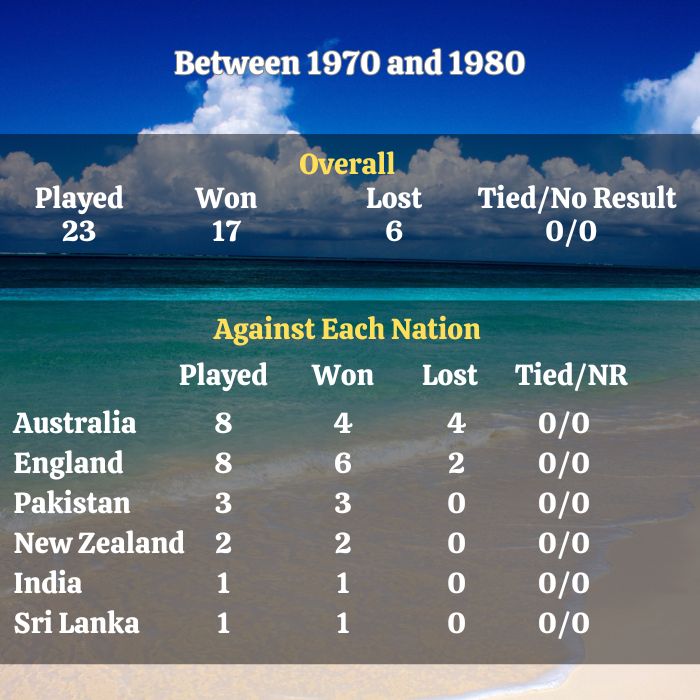
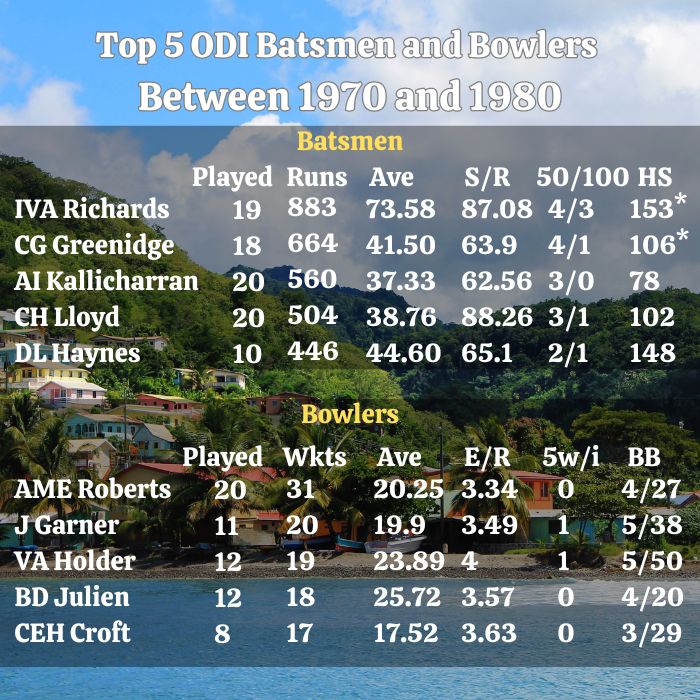
Conclusion
We hope you have enjoyed this part 2 of the History of Cricket in the West Indies. Part 3 will continue with the 1980s and 1990s, where we will see the continued rise of the great West Indian cricket, before the decline of the last 1990s.

